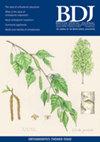Patterns of balancing and compensating primary tooth extractions among paediatric dentists
IF 2
4区 医学
Q2 DENTISTRY, ORAL SURGERY & MEDICINE
引用次数: 0
Abstract
Introduction Balancing and compensating extractions (BCEs) of primary teeth aims to minimise the development of more severe malocclusions and reduce the need for subsequent complex orthodontics. Purpose To assess the demographics, practice characteristics and clinical preferences of United Kingdom paediatric dentists for BCEs of primary teeth. Methods All members of the British Society of Paediatric Dentistry were sent an electronic questionnaire. Questions offered frequency options (always/frequently, often/sometimes and rarely/never) for a range of clinical scenarios in patients up to five years and between 6-9 years. Results Of the 288 specialists invited, 67 (23.3%) completed the questionnaire. Respondents were mostly female (n = 55; 82.1%), with most working in secondary care (n = 51; 77.3%). The majority (n = 54; 81.8%) supported the application of guidelines. A total of 39 paediatric dentists (58.2%) always/frequently encountered BCEs, with 31 (46.2%) performing BCEs in over 40 patients in the past year. Additionally, 40 respondents (59.7%) reported always/frequently complying with guidelines. Data from 65 respondents indicates that 83.6% (n = 56) rarely/never made referrals to an orthodontist, while 65.7% (n = 44) rarely/never consulted an orthodontist (p <0.001). Conclusions There was variation across clinical scenarios, with good adherence to guidelines in BCEs of primary teeth among paediatric dentists. However, there was limited interdisciplinary collaboration with orthodontists.

求助全文
约1分钟内获得全文
求助全文
来源期刊

British Dental Journal
医学-牙科与口腔外科
CiteScore
3.10
自引率
15.40%
发文量
1096
审稿时长
4-8 weeks
期刊介绍:
The role of the BDJ is to inform its readers of ideas, opinions, developments and key issues in dentistry - clinical, practical and scientific - stimulating interest, debate and discussion amongst dentists of all disciplines. All papers published in the BDJ are subject to rigorous peer review.
 求助内容:
求助内容: 应助结果提醒方式:
应助结果提醒方式:


